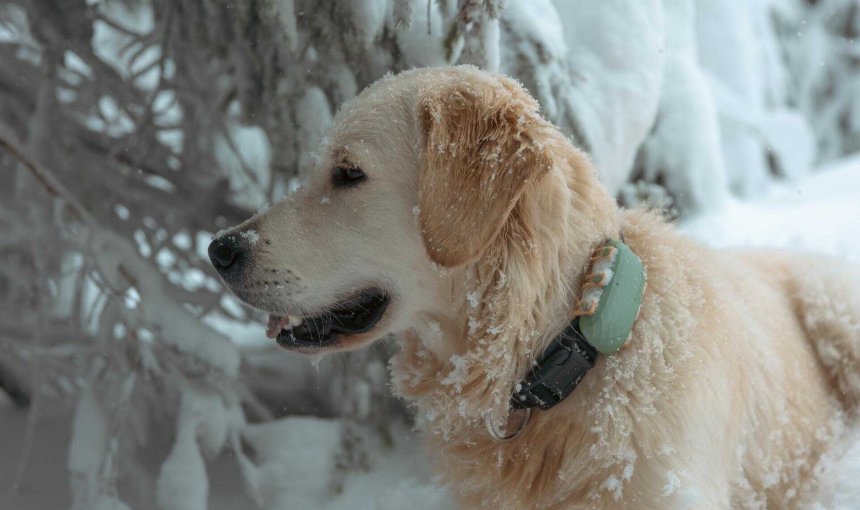How To Protect Dog Paws In Winter & Snow
Our furry pals need our help this winter - they can't protect themselves from cold weather paw dangers on their own. When cold temperatures, ice and snow, and other hazards could harm your dog, be prepared to keep them and their paws healthy and safe.

As a dog parent, you know paw care is key to keeping your furry friend happy. You know it’s important to check, groom, and protect their paws regularly. But do you know how to protect dog paws in winter and snow? During fall and winter, dogs paws are especially vulnerable.
Because just like us, dogs are sensitive to cold. Exposure to cold air, rain and snow can cause chapped paws and dry, itchy skin. Then there’s things like ice, chemicals and melting salts that can hurt your dog. But the good thing is, we can show you how to protect dog paws in snow, both during fall and winter.

Always know your buddy is healthy & safe
Read moreDo dog paws get cold in the snow?
Unlike the rest of a dog’s body, dog paw pads don’t have fur on them to keep them warm. However, researchers in Japan found that canine footpads have a heat-conserving ability which can help regulate their temperature in cold environments1.
Still, some dogs are better protected from snow and cold temperature than others. For example, these snow loving dog breeds are much better suited for a snowy winter day than say, a chihuahua. However no dog is completely safe from frostbite, or other dangers posed by harsh winter weather.
Read more: How Cold Is Too Cold For Dogs?
Potential dangers for dog paws in snow
Winter and especially snow bring a few potential dangers for dogs and their paws that every dog parent should be aware of. Including:
- Dryness, cracking, and chapping: The dry air and cold temperatures of winter can dry out paw pads and cause irritation.
- Freezing temperatures and frostbite: Even the most winter-ready dog is susceptible to frostbite if temperatures get too cold. Small, shorthaired, young, old and sick dogs are especially vulnerable.
- Toxic chemical agents on streets: De-icing salt, antifreeze and other substances could cause chemical burns on your dog’s paws. They also could make your dog sick if ingested.
- Objects hidden under snow: Sharp objects under snow could cause cuts and other injuries.
Dogs in the snow are also at risk for slips and falls and even hypothermia.
How to protect dog paws in winter and snow
Baby, it’s getting cold outside 🥶… here’s what you can do to protect your dog’s paws from snow and freezing temperatures this winter.
- Moisturize paw pads
- Keep your dog hydrated
- Keep walks short
- Steer clear of de-icing agents
- Clean dog paws after winter walks
- Groom dog paws regularly
- Use dog boots
- Keep an eye on your dog’s paws
1. Moisturize dog paws
Many of us need a little extra moisture in winter. And our furry friends can benefit from this too! Use a store-bought dog paw balm, such as Vitamin E cream, or a homemade recipe like the one below to protect your dog’s paws in snow.
Homemade dog paw balm recipe
Ingredients:
- 80 ml olive oil
- 30 g organic shea butter
- 15 g beeswax
- 20 g pine resin (collected or ordered online)
- 3 tsp marigold (don’t have any? ask your neighbor if they have some in their garden)
- 1 small jam glass to store the cream
Instructions:
- Put all the ingredients together in the glass.
- To melt and combine the ingredients, put the glass inside a bowl of hot water for approximately 30 minutes (being careful not to get any water into your mixture).
- When you notice the cream starting to get a medium consistency (not too thick and not too runny), take it out, put it in another glass and leave it to cool down.
This recipe makes 150 grams of homemade dog paw balm. All these ingredients are very powerful when used together; some have anti-inflammatory properties, while others have a calming effect on the skin.
The balm can be applied anytime; after a bath, after exposure to cold air, or just before you put on your dog’s shoes. Your pup will love being pampered after receiving their dog paw moisturizing treatment!
2. Keep your dog hydrated
Just like us, it’s important that our furry friends drink enough water. Even more so in winter, when the dry air and cold temperatures can easily dry out skin and paws. Always provide plenty of water to your dog, and don’t forget to bring some along on your walks too!
Infographic: How much water does a dog need in a day?
3. Keep walks short
In general, frequent shorter walks are safer for your dog in winter than a single long daily walk. When considering how long to walk with your dog in winter weather, it’s important to consider the temperature and conditions as well as your dog’s breed and overall health. Some breeds are made for the snow and will love romping around outside for hours despite the cold. For others – a 15 minute walk will be enough to leave them freezing. And ready to ready to warm up on the couch again. So pay attention to your dog and get them inside again before it becomes too cold for them.
4. Steer clear of de-icing agents
De-icing agents are chemical substances put on the sidewalk and street to melt ice. Since these can harm dog paws, avoid any slushy or salty areas on your walks.
5. Clean dog paws after walks
Whether walking through city or country, avoiding all the ice-melting salt on the roads can be almost impossible in winter. So be sure to clean your dog’s paws as soon as you’re back home. Warm water and a cloth should do the trick. Then of course, make sure your dog doesn’t stay wet for too long. Dry your furry friend off with towels and let them sit by the fireplace if you have one.
While walking, have a towel on hand to immediately clean any snow, salt or debris that gets on your dog’s paws.
6. Groom dog paws regularly
Good grooming is essential for healthy winter feet. Trim long-haired dogs to make it harder for bits of ice, salt crystals or ice-melting chemicals to dry and cling to their skin. Take special care when doing their feet, and trim any extra hair growing on the paws. And don’t forget to trim dog nails.
7. Use dog boots
Just as wearing boots in the winter protects your feet, dog shoes or booties will prevent injury and protect dog paws in snow. Dog boots will protect your dog’s paws from salt, ice balls and sharp items that may be hidden under the snow. Your pup may not like the boots at the beginning but, with a little time and patience, you can train your dog to love wearing their booties!
8. Keep an eye on your dog’s paws
To really protect dog paws in winter and snow, you’ll need to monitor them regularly. Watch out for cracks, wounds or any other potential issues. And if your dog starts licking their paws more than usual – there may be an underlying problem. When in doubt about your dog’s wellbeing, it’s a good idea to contact your vet.
Another way to ensure your dog’s wellbeing
You love your dog and you want to keep them safe and sound, understandably. That’s why we created the Tractive GPS & Health tracker for dogs. It allows you to:
- See where your dog is anytime and find them if they go missing.
- Keep an eye on your dogs activity levels.
- Monitor their sleep
- Get alerted in case there’s any changes to your dog’s behavior that you should be aware of.
Tractive has even saved the lives of dogs and cats who’ve wandered off or bolted away from safety. Like Imogen, a high-energy Borzoi who ran off past her yard – and crashed through the ice into a frozen lake nearby. Luckily, her mum was able to quickly track her down with the help of her Tractive device. Using it’s Location History, she was able to quickly find Imogen and rescue her from drowning and freezing.

Follow your dog anywhere
Get real-time location information, wherever they go. And find out when they try to make an escape, or just when they go somewhere they shouldn’t, with Virtual Fences.
The bottom line on protecting dog paws in winter
During winter time, try to care for your dog’s feet like you do your own. When your feet get cold, sore, and blistered, the discomfort can make you miserable. Your dog feels the same way. Pay attention to your dog’s behavior to check for any signs of discomfort or distress. Show your dog a little love during winter by taking good care of their paws.
More winter care tips for dogs
- Checklist: 8 Winter dog safety tips you need to know
- Winter holiday with your dog
- 4 fun dog-friendly winter activities to try with your dog in snow
- How to find the perfect dog jackets for winter
- Dogs and cold weather: How cold is too cold for dogs?
- 15 best outdoor dog breeds that can live outside
- Can my dog catch my cold? Get this answered once and for all!



